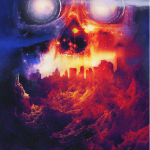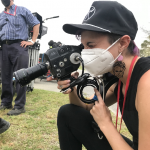Cultural views are constantly evolving to support the ever-changing circumstances that people endure together. Both the characters in, and filmmakers of, the new anthology horror movie, ‘V/H/S/99,’ are highlighting the swift transformation in how society perceives different groups of people, particularly women and teenagers.
The drama, which is the fifth installment in the cult ‘V/H/S‘ movie franchise, had its World Premiere on September 16 in the Midnight Madness section of the Toronto International Film Festival (TIFF). The movie is now streaming exclusively on Shudder, and become the platform’s most-viewed premiere when it debuted on October 20.
In a break from its traditional wraparound structure, the found footage series’ latest edition of cursed recordings are instead layered over each other on a single videotape, with the earliest recording running beneath the others, occasionally breaking through in bursts of static and analogue tracking errors. The innovations continued with respect to style and tone, as Blumhouse Productions alum Maggie Levin infused the franchise’s famed found-footage concept with a pure camcorder perspective for taped-off-TV broadcasts of quintessential ’90s programming gone horribly wrong.
Verona Blue stars in ‘V/H/S/99’ as punk rocker Deirdre in the segment titled ‘Shredding,’ which was written and directed by Levin, who’s also a renown genre filmmaker. (She previously penned and helmed the 2020 horror-thriller movie, ‘My Valentine,’ for Hulu’s ‘Into the Dark’ series.)
Levin and Blue generously took the time the week before ‘V/H/S/99’s premiere at TIFF to talk about scribing, directing and starring in the ‘Shredding’ segment during an exclusive interview over Zoom. Among other things, the writer-helmer and actress discussed that they were both interested in working on the project because they intrigued to work on a franchise that has a reputation for offering its filmmakers extensive creative freedom, spontaneity and the ability to push boundaries. The duo also mentioned how they were honored that the drama debuted at such a prestigious festival as <a href="http://TIFF“>TIFF.
ShockYa (SY): Maggie, you wrote and directed the ‘Shredding’ segment of the new anthology horror film, ‘V/H/S/99.’ What inspired you to want to become involved in the series?
Maggie Levin (ML): It’s incredible, as a filmmaker, to be asked to be included in this legendary cult franchise that has a reputation for incredibly creative freedom, spontaneity and boundary pushing. I became involved because the long-time producers approached me, initially about being a part of ‘V/H/S/94,’ but I was working (as the second unit director) on ‘The Black Phone’ at the time, so the timing didn’t work.
Very fortunately and sweetly, they kept me in mind when they found out that they were making ‘V/H/S/99.’ They approached me to see if I had any concept ideas, and I worked it out with them. As part of the concept process, I knew very quickly because of the subject matter that I wanted to include a music component to it, and ideally, write a part for one of my dear actress friends, who’s sitting right here!
SY: Verona, speaking of the fact that you star in ‘Shredding’ as Deirdre, what was it about the character, as well as the overall story, that convinced you to take on the role?
Verona Blue (VB): This was one of the easiest and best acting jobs I was able to get in my career. It’s fantastic when you have someone who loves you and sticks their neck out for you.
Obviously, at any point, production can make another decision. But very fortunately, the producers are cool people and have a similar aesthetic and really get the culture around horror, obviously. They get the people who are really into it. So they were on board, and knew the concept from Maggie. They saw my pictures and work, and fortunately liked me. I was also fortunate enough to get to work with Maggie in the past, so when this project came up, it was the perfect match for both of us.
SY: Maggie, what was the process of coming up with the idea for the segment and penning the script for it?
ML: When you’re working on the ‘V/H/S’ series, you’re working in the area of found footage, and with this film, we also have the headline of it taking place in 1999. So it was about freeing my mind in those specific confines. It was also about nor only figuring out things that were both new and fresh for found footage, but also authentically vintage to 1999. So the segment became a fusion of those two things with some of my own personal 1999 experiences. That blended together to create the cocktail that become the segment called ‘Shredding.’
We are being very mindful about spoilers, because we want audiences to be shocked ans surprised by it. But I can say that the film deals in the area of prank videos, teenage 1999 hubris riot girl bands and spooky things. (Levin laughs.)
SY: Speaking of the riot girl band element of ‘Shredding,’ what was the process like of creating the music and score for the segment?
ML: I worked with a really incredible composer, Keeley Bumford Dresage, who’s a frequent collaborator of mine. She’s an absolute wizard at creating authentic songs for any genre for any era, and she did that here.
Verona and her cohorts, who you meet in the form of a rock band, also brought a component. We were going for real authenticity, but I don’t think Verona’s ever been in a band. But she is heavily involved in the culture surrounding music that I think she can tell you about.
VB: Yes, my dream is to be in a ska band. I don’t currently play any of the appropriate instruments, though, but I did briefly play the drums – not very well, though, and not well enough in any band.
But I was a teenage goth, and now I’m an adult goth. It’s such a music-based genre.
This is a weird fact about me: I’m one of those people who can’t picture things in my mind, and a lot of memories are stored in music. So as I move through the world, I pull my memories from the sounds that I hear.
So for the 1999 film to be rooted in music and a specific subculture with certain kinds of people really lent itself to the story. Essentially, the entries in ‘V/H/S’ are short films, which very quickly inject their stories’ essence on screen through snippets of found footage, and you feel like they’re transported out of time.
A lot of that has to do with how all of these subcultures, from goth to punk and skate, are all deeply rooted in all kinds of music. So I just listened to a lot of music, including songs that didn’t come out until after 2000, which really meshed well for me.
SY: Speaking of ‘V/H/S/99’s found footage element, what was the experience like of creating that visual style, as both the filmmaker and lead actress, throughout the production?
ML: It’s such a joy to have unique creative boundaries in a project like this. I use boundaries exclusively as a positive word. Those corralling elements give me, personally, a bigger, more inventive space to create in.
It was really one of the highlights of the whole experience. Getting to use era-authentic cameras was amazing; we shot a lot of (‘Shredding’) on the Sony VX1000, which is perhaps a meaningless term to some people. But when you show up at a skate park with this camera to film, it’s like bringing a celebrity by; people flock to it. It’s a very famous skate video camera.
It had a certain magical glow to it, but we also did dual shooting on a modern camera. But the footage that we got off of the old camera looked just an extra bit better. We also shot some of the band footage on film.
My editor, Andy Holton, worked very hard, as well as the entire design team, including the production designer, Britt Keller. Everyone went above and beyond to make sure that everything that Verona was talking about immediately transports you to a certain time and place. You’re really dropped in for 20 minutes to a time and a place, and you know exactly who these people are and what they’re doing because of the components built around them.
VB: The thing that I think is really enjoyable, from a performance perspective, is that the other actors who were part of the band and I really all fit together. We had fittings and rehearsals. The other actors, including Tybee (Diskin), Kelley (Missal) and Aminah (Nieves), were all great. I already knew Tybee from before we worked on this film together, but I had never met Kelley and Aminah before.
But we all had to immediately goof off together because we had to get all of this B-roll for the band that comes in glitches. So we had to find a friendship that really feels authentic, like these are women who truly travel around together in somebody’s van from city to city for each show.
We all also knew that shooting on film, there’s no sound, so we could just be stupid and look like we’re having a great time, because we were having a great time.
ML: Yes, I think you buy the chemistry because it was really there and instantaneous. That’s a credit to all of your abilities.
VB: I agree. It was great to have all of these different cameras. I’ve also worked with Maggie before, so she respects the vanity of all of us actors, and knows we want to look good! (Levin laughs.)
So having all of these different cameras really helped with that. When I see a cut of the film, I know she and Andy chose the best shots. So you feel proud of, and happy with, the finished film, partially because there are all of these different cameras creating these different textures, which is something you don’t normally get. Normally, you have Camera A and Camera B and they’re enormous and far from your face. But we had handicams, which was very cool.
SY: Besides the music, the costumes the characters wear are also another major component to the story that’s featured in ‘Shredding.’ Did you embrace the mid-late 1990s looks that the characters had in the segment?
VB: We’re all wearing essentially period costumes, which feels weird to say about 1999. Everyone had wild hair, accessories and make-up. While we saw each other at fittings, we were doing these little fashion shows, which was fun…But it was weird because we wold walk into the room with all of these kids who were wearing popular looks from the ’90s, including JNCO jeans and spiky bracelets.
SY: ‘V/H/S/99 (had) its World Premiere at this year’s TIFF. What does it mean to you both that the movie debuted during the festival?
ML: I cannot describe my excitement, as to be asked to go to TIFF is an honor. Plus, to be able to go there with not only people I met on this project, but also people like Verona, who I have a history with, is amazing. To be able to carry our artistic partnership all the way through to this esteemed festival is really extraordinary. I also think it means a little more to Verona in particular.
VB: Yes, I’m from Toronto, as I grew up there. So not only is TIFF an incredibly lauded festival, it’s also my home festival. When I grew up, if I ever went to festival movies, it was always at TIFF.
When I was in university and living downtown, I would crash screenings and parties and see all the big name people walking around. It was a great experience for someone who wasn’t in the industry yet in any way.
So now to be able to go home and be in something that (premiered) there is definitely a bucket list thing for me. Like Maggie said, to be able to do it with a project I love with someone I love as a co-worker and a friend is so cool. I think any festival is cool, but when it’s your homebase, it’s extra special.
ML: It’s the dream! To be able to parade into your hometown and say, “I did it, guys!,” is great!



